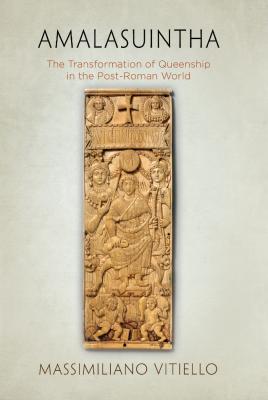ТОП просматриваемых книг сайта:
Amalasuintha. Massimiliano Vitiello
Читать онлайн.Название Amalasuintha
Год выпуска 0
isbn 9780812294347
Автор произведения Massimiliano Vitiello
Жанр История
Издательство Ingram
Amalasuintha
AMALASUINTHA
The Transformation of Queenship in the Post-Roman World
MASSIMILIANO VITIELLO
UNIVERSITY OF PENNSYLVANIA PRESS
PHILADELPHIA
Copyright © 2017 University of Pennsylvania Press
All rights reserved. Except for brief quotations used for purposes of review or scholarly citation, none of this book may be reproduced in any form by any means without written permission from the publisher.
Published by
University of Pennsylvania Press
Philadelphia, Pennsylvania 19104-4112
Printed in the United States of America on acid-free paper
10 9 8 7 6 5 4 3 2 1
Library of Congress Cataloging-in-Publication Data
Names: Vitiello, Massimiliano, author.
Title: Amalasuintha : the transformation of queenship in the post-Roman world / Massimiliano Vitiello.
Description: 1st edition. | Philadelphia : University of Pennsylvania Press, [2017] | Includes bibliographical references and index.
Identifiers: LCCN 2017005982 | ISBN 9780812249477 (hardcover)
Subjects: LCSH: Amalasuntha, Queen of the Ostrogoths, 498–535. | Ostrogoths—History. | Queens—Italy—Biography.
Classification: LCC DG508 .V57 2017 | DDC 945/.01092 [B]—dc23
LC record available at https://lccn.loc.gov/2017005982
Dedicated to the memory ofIl maestro Bruno Conflitti († Campoli Appennino 2015)and Professor Shona Kelly Wray († Florence 2012)
Contents
Map of Europe and the Mediterranean World at the Beginning of Amalasuintha’s Regency, Late A.D. 526
Genealogy. The Family of Theoderic
Chapter 1. Mother, Regent, and Queen: Amalasuintha and the Institutions of Power
Chapter 2. Amalasuintha at the Palace of Ravenna: The Making of a Queen
Chapter 3. A Regent with Imperial Ambitions
Chapter 4. Balancing Gothic Tradition with Roman Ideals
Chapter 5. Amalasuintha: A Meeting Point Between Kingdoms and Empire
Epilogue. Amalasuintha’s Legacy in Early Medieval Italy
Author’s Note
I came to the idea for this book during my work on Cassiodorus’s letters for the new commentary and translation of the Variae (edited by Andrea Giardina, Giovanni Alberto Cecconi, and Ignazio Tantillo) and through the research for my recent monograph Theodahad: A Platonic King at the Collapse of Ostrogothic Italy (2014). I was surprised to find a dearth of scholarly literature on Amalasuintha. It seemed to me that this important figure would quite naturally stand at the center of a work on female power in late antiquity and the early Middle Ages. My monograph on Theodahad had just appeared when I took courage again, and I decided to devote an entire book to Amalasuintha.
This book is not a companion to Theodahad. In addition to being a study of Amalasuintha’s life, it is an investigation of the idea of female power in the fifth and sixth centuries, and in particular of the experimental use of political models by a woman in power to solve the succession crisis following Theoderic’s death. The book is an effort to fill the very real need for a scholarly exploration of Amalasuintha and her political representation.
The Family of Theoderic
Synthesized stemma of the late Amals, based on PLRE II:1330; König 1997; Francovich Onesti 2007:24–25. Names of kings of other tribes in italic.
Introduction
In 1733 Carlo Goldoni presented his first play in Milan, a tragedy with the title Amalasunta. The work was critiqued so harshly that the author, despairing, finally threw it into the fireplace, and Amalasunta turned out to be the tragedy of a tragedy.1 Popular legends about Amalasuintha’s fate in beautiful Lake Bolsena are plentiful. Still today, the fishermen claim that during the windy days of the tramontana they can hear the wailing of the Gothic queen, her desperate cries coming from the small lake island of Martana, where she is believed to have spent the last days of her life.2 The northern wind that encourages the little waves whispers this melancholy story over and over again to the people of Marta, the small village that lies just southeast of the island. Almost fifteen hundred years after her death, Amalasuintha’s last days still echo on Lake Bolsena, between the little island and the still waters that surround it.
If much of this tragic, literary Amalasuintha is the stuff of legend, the woman herself was certainly real. Queen Amalasuintha was one of the most significant women of power in her day. She was the daughter of Theoderic the Great, the Gothic king and hero who defeated Odovacer and made Italy his kingdom. Her portrait is preserved not on mosaics but rather in some letters of Cassiodorus and in the histories of Procopius of Caesarea. Over the past century, the queen has become the object of scholarly interest as a political figure. More recently, her life story has attracted the attention of gender historians. But direct evidence is sparse, so she has usually been discussed in single entries in encyclopedias and occasionally in articles.3 While some scholars have attempted more comprehensive studies, no scholarly monograph has been devoted to Amalasuintha. Ginetti’s 1901 study focused on religious policy and the administration

